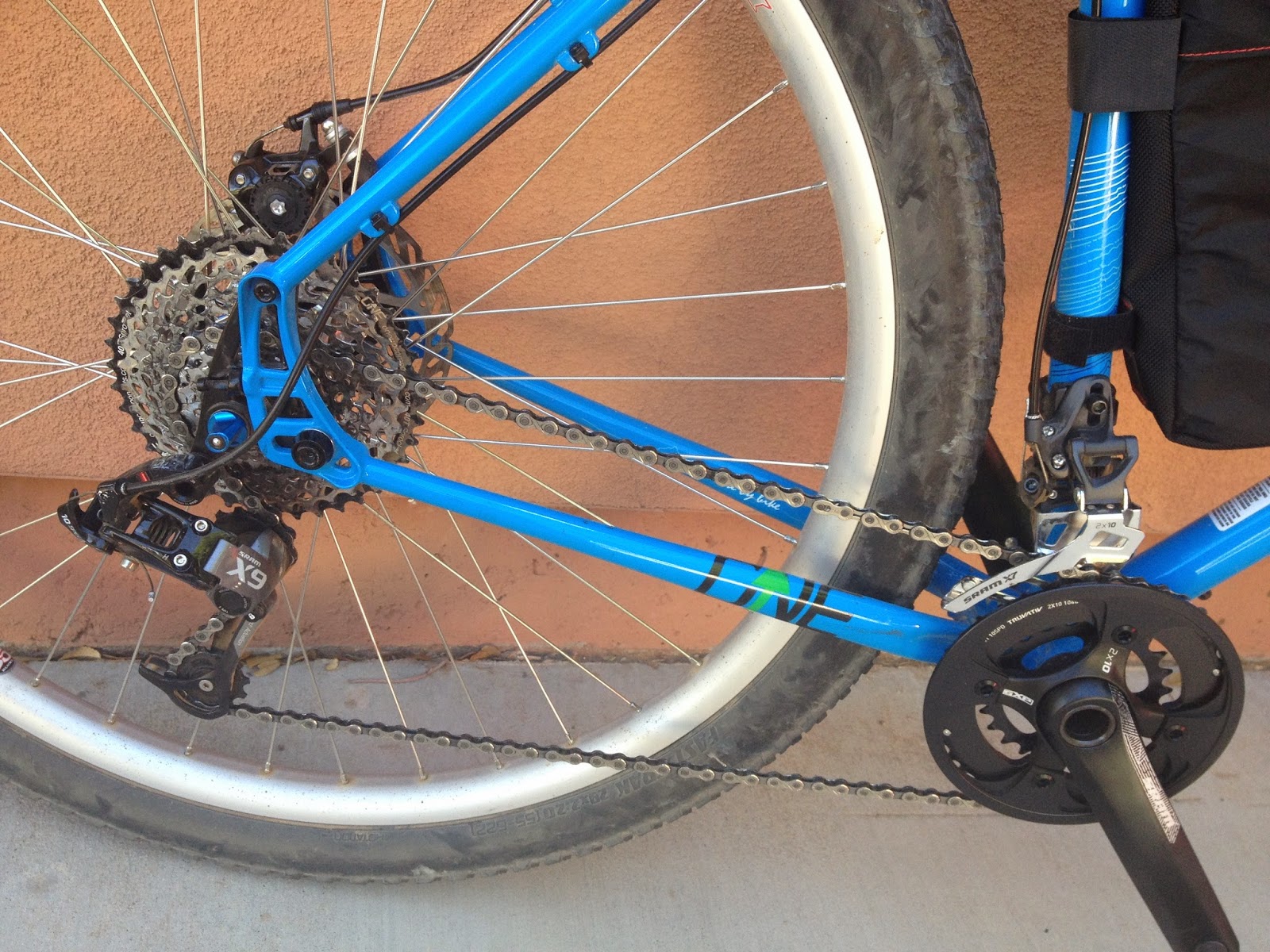So, Salsa Fargo 2. Steel frame, drop bars. A great bike. How do I make it better? More specifically, how am I going to tailor this bike for my use as an overland back country survival vehicle? The Tour Divide takes place mainly on backroads and trails, with a little bit of single-track and a whole lot of climbing. So what about this bike needs to change?
First modification: wheels. There's a growing body of evidence that suggests that for mountain biking, wider rims make more sense than the beefed up narrow rims found on most mountain bikes today. Less burping, better float, less deformation, reduced rolling resistance, yada yada yada. All very controversial and subject to personal preference, but it makes sense to me. So I had Peter White build up a new set of wheels using Velocity Blunt 35's drilled to fit a Schrader valve. Why Schrader? How many back country gas stations have a compressor with a Presta tire filler? That's right - zero. Rear hub is a Hadley 135mm QR, and up front I'm running a Schmidt SON 28 15, a dynamo hub that outputs 6W at 9mph - enough to run a headlight and keep my phone charged. Wheels are set up for tubeless, and I'm running Specialized Fast Trak Control 29x2.2" tires. They're light, they're fast and they're quiet, even on pavement. I love my wheels.
What about the stock wheels? I set them up with Schwalbe Marathon HS 420s. I've taken them out a few times, but they're less comfortable and no faster than the Fast Traks, so I leave them at home and use them on the trainer.
What about the stock wheels? I set them up with Schwalbe Marathon HS 420s. I've taken them out a few times, but they're less comfortable and no faster than the Fast Traks, so I leave them at home and use them on the trainer.
By the way, cost of a complete bike plus custom wheels was about the same as the cost of a naked frame & fork set built up from scratch. This way, though, I have a second set of wheels to train with. Food for thought.
 |
| Modified wheels & drivetrain. This mule is built to climb. |
Third modification: cassette. The stock cassette is a SRAM PG1050, which I left on the stock rear. For the custom wheel, I added a SRAM PG1070 11-36 cassette, and to that I added a OneUp 40T granny gear. The handy thing about the OneUp kit is that comes with a 16T cog as well. Instead of making room for the 40T cog by simply yanking one of the higher cogs - say 17T - and being left with a jump of 15T to 19T in the upper gears, you can pull out the 15T and 17T cogs, and replace them with the new 16T cog. It does wonders to smooth out the shifting, and overall the system works as well as the stock cassette.
Now, the Tour Divide is largely about climbing, so let's talk ratios for a minute. My Santa Cruz Tallboy has a 3x crankset with a 24T chainring up front, and a 36T cog on the back, resulting in a granny gear ratio of 24/36 = 0.667. Decent, but I still end up walking more than I'd like on Crown King Road. Definitely not low enough for loaded backroad touring, IMHO. On the high end, Tallboy and Fargo both have a 42T chainring mated to a 11T cog resulting in a final drive ratio of 42/11 = 3.82. Nice. Now, the stock 2x Fargo crankset has a low ratio of 28/36 = 0.778 - much higher than the Tallboy, and way too high for the kind of climbing involved in the TD (again, IMHO). Now, if I were simply to drop the front chainrings down to 22/36, that would result in a granny gear ratio of 22/36 = 0.611. That's a significant improvement on the low end, but the penalty comes on the high end, where the final drive ratio is reduced to 36/11 = 3.27. Not terrible, but not ideal either. With the crank/cassette mods I listed above, my granny gear ratio is 24/40 = 0.6 (!), and the final drive ratio is 38/11 = 3.45. Happy medium.
Why so low, you ask? With a low ratio of 0.6, I'll probably spin out at about 5 mph, and have a comfortable cadence somewhere between 3 and 4 mph. One could argue that I could get off the bike and push it nearly as fast as I could ride it in low gear. Maybe, but at least with this gearing, I'm still on the bike, and I'd rather ride the bike than push it whenever I can. Personal preference.
There are other modifications having to do with contact points, but I'll save that for another day.
It's coming together.
-David
